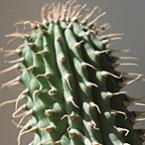Hoodia

On this page:
Introduction
This fact sheet provides basic information about hoodia—common names, what the science says, potential side effects and cautions, and resources for more information.
Hoodia is a flowering, cactus-like plant native to the Kalahari Desert in southern Africa. Its harvest is protected by conservation laws. Historically, Kalahari Bushmen ate hoodia stems to reduce their hunger and thirst during long hunts. Today, the main folk use of hoodia is as an appetite suppressant for weight loss.
Dried extracts of hoodia stems and roots are used to make capsules, powders, and chewable tablets. Hoodia can also be used to make liquid extracts and teas. Hoodia products often contain other herbs or minerals, such as green tea or chromium picolinate.
What the Science Says
There is no reliable scientific evidence to support hoodia’s use. No studies of the herb in people have been published.
Side Effects and Cautions
- Hoodia’s safety is unknown. Its potential risks, side effects, and interactions with medicines and other supplements have not been studied.
- The quality of hoodia products varies widely. News reports suggest that some products sold as hoodia do not contain any hoodia.
- Tell all your health care providers about any complementary health practices you use. Give them a full picture of what you do to manage your health. This will help ensure coordinated and safe care. For tips about talking with your health care providers about complementary and alternative medicine, see NCCAM's Time to Talk campaign.
Search the scientific literature for potential herb-drug interactions
Sources
- Hoodia. Natural Medicines Comprehensive Database Web site. Accessed at www.naturaldatabase.com on July 15, 2009.
- Hoodia (Hoodia gordonii). Natural Standard Database Web site. Accessed at www.naturalstandard.com on July 15, 2009.
For More Information
NCCAM Clearinghouse
The NCCAM Clearinghouse provides information on NCCAM and complementary health approaches, including publications and searches of Federal databases of scientific and medical literature. The Clearinghouse does not provide medical advice, treatment recommendations, or referrals to practitioners.
PubMed®
A service of the National Library of Medicine (NLM), PubMed® contains publication information and (in most cases) brief summaries of articles from scientific and medical journals.
Office of Dietary Supplements (ODS), National Institutes of Health (NIH)
ODS seeks to strengthen knowledge and understanding of dietary supplements by evaluating scientific information, supporting research, sharing research results, and educating the public. Its resources include publications (such as Dietary Supplements: What You Need to Know), fact sheets on a variety of specific supplement ingredients and products (such as vitamin D and multivitamin/mineral supplements), and the PubMed® Dietary Supplement Subset.
This publication is not copyrighted and is in the public domain. Duplication is encouraged.
* Note: PDF files require a viewer such as the free Adobe Reader.
